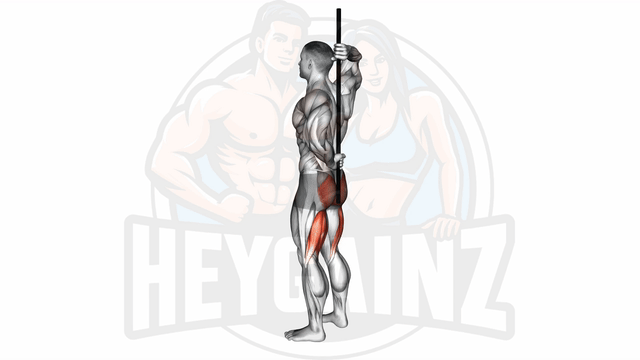
Instructions:
- 1Stand upright and hold the PVC pipe vertically behind your back
- 2Ensure the pipe has three points of contact: your head, mid-back and hips
- 3Bend at your hips and push your backside out while maintaining the three points of contact with the pipe
- 4Pause for a moment in the hinged position
- 5Return to your standing position
Tips:
- Keep your spine neutral throughout the movement
- Bend your knees slightly to take any strain off them
- Focus on using your hamstrings and glutes to drive the movement
- Don't rush the movement. Take your time to ensure you're doing it correctly
PVC Hip Hinge: A Comprehensive Guide
The PVC hip hinge is an essential exercise designed to enhance hip mobility and strengthen the gluteus maximus. Using a simple stick as equipment, this movement is accessible to individuals at any fitness level. Whether you're a beginner or an experienced athlete, understanding the mechanics of the hip hinge can significantly improve your performance in various activities.
What is a Hip Hinge?
The hip hinge is a fundamental movement pattern that involves bending at the hips while maintaining a neutral spine. This technique is crucial for performing exercises such as deadlifts and squats effectively and safely. By mastering the hip hinge, individuals can improve their athletic performance, prevent injury, and enhance overall functional strength.
Benefits of the PVC Hip Hinge
- Strengthens the Glutes: Targeting the gluteus maximus, this exercise helps increase strength and power in the posterior chain.
- Improves Mobility: Regular practice of the PVC hip hinge enhances hip flexibility and range of motion, which is beneficial for various sports and daily activities.
- Promotes Proper Mechanics: Learning the hip hinge technique can translate to better form in more advanced exercises, reducing the risk of injury.
How to Perform the PVC Hip Hinge
To execute the PVC hip hinge properly:
- Stand with your feet shoulder-width apart and grasp a PVC stick horizontally across your back with both hands.
- Keep your shoulders pulled back and your core engaged as you hinge at the hips, allowing your torso to lean forward while maintaining a neutral spine.
- Push your hips back, feeling the stretch in your hamstrings, and return to the starting position.
Tips for Effective Practice
- Maintain Neutral Spine: Always keep your spine in a neutral position to avoid strain. Engage your core throughout the movement.
- Use Slow and Controlled Movements: Focus on the mechanics of the movement rather than speed to build proper muscle memory.
- Explore Variations: Consider trying the banded PVC hip hinge or other hip hinge alternatives to further enhance your training routine.
In summary, the PVC hip hinge is a powerful exercise that forms the foundation for many other movements. Understanding what a hip hinge is and how to perform one correctly is beneficial not only for specific workouts but also for daily activities. By integrating this simple yet effective exercise into your regimen, you can improve your strength, mobility, and overall fitness level.